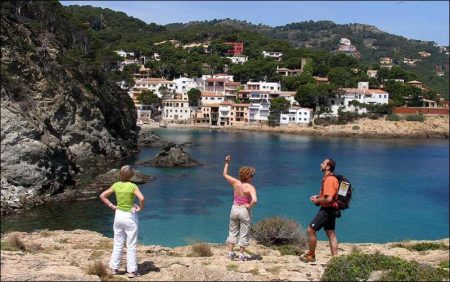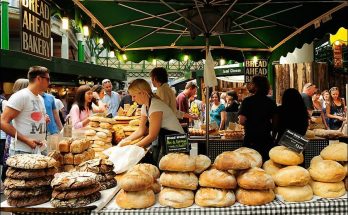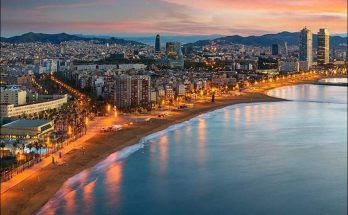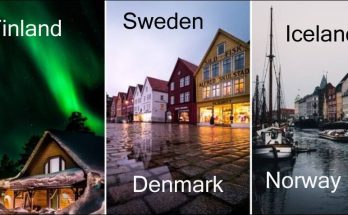This area is not typically Spanish. There is adequate rainfall, a good deal of industry, a different language (Catalan), and a middle class. Here people are often better informed about national and world affairs than those further south, and throughout Catalonia’s rather troubled history the desire for secession from the rest of Spain has been apparent.
The region consists of the eastern end of the Pyrenees and contains a variety of rocks, from Archaean granite to Quaternary alluvium. Many of the rocks are porous, while some areas show evidence of vulcanicity, for example the igneous rocks which appear along the coast north of Barcelona. Such complex structure gives rise to very irregular and dissected country, there being a series of alternating valleys and ridges that, at first, appear to have little plan.
The narrow coastal plains, composed of late Tertiary and Quaternary deposits, are backed by a line of hills; Montseny and Guilleries are formed of Palaeozoic limestones and shales, while the strangely weathered peaks of Montserrat reveal Tertiary sandstone and conglomerate formations. These hills fall abruptly to a long narrow valley containing such towns as Sabadell and Tarrasa. This valley is thought to be a type of rift valley, and continues northwards to the basin of Ampurdán, which is probably a faulted depression. Both these large earth hollows are floored with alluvium, and rivers crossing them break through the littoral hills to the sea.
Rivers in this area include the Muga which, like the Fluvia, comes to the sea in the Gulf of Rosas, the Besós and the Llobregat which together have formed a large coastal alluvial plain, the Ter, and to the south of the area, the Ebro. The Ter, Llobregat and the Ebro alone rise on the landward side of the coastal hills and are the three longest rivers of Catalonia; the Ter has a length of 104 miles, the Llobregat of 100 miles, and the Ebro, 465 miles long, annually carries 7,500 million cubic metres of water towards the Mediterranean, losing much on the way through evaporation and irrigation. The other rivers are shorter, and in their upper courses have a large volume of water throughout the year. Downstream they are used for irrigation or hydro-electricity to such an extent that very little water ever reaches the sea.
Catalonia as a whole has a typically Mediterranean climate, with more than average amounts of rain and snow on the highland areas. The coast and interior valleys receive a moderate rainfall ( Tarragona 20 inches a year, Barcelona 21 inches a year and Manresa 20.5 inches a year), while the hills are wetter (Viladran 33.6 inches per year and Berga 33 inches per year). Heavy storms are liable to occur in autumn, the wettest season, and sometimes in spring, but generally sunshine prevails.
Precipitation is adequate for agriculture, especially where the land is flat enough for irrigation to be practised. Winters are mild (the average temperature of the coldest month at Barcelona is 47° F.), though subject to the tramontana, a cold north wind, similar to the mistral. Summers are not excessively hot (the average temperature of the hottest month at Barcelona is 74° F.), and are occasionally tempered by the garbi, a marine breeze which at times reaches the Ebro basin.
Agriculturally the region is rich, the climate, the fertility of much of the soil, and the patient hard work of the Catalans, all helping to improve conditions year by year. Many types of vegetables and fruits are grown, especially close to the large towns and cities, to supply the needs of the inhabitants. Olives and vines grow in profusion, often up to unusual heights in sheltered spots, while cereals are important, and sheep and goats as well as cattle are reared. Irrigation is practised to increase the yields of many crops.
In some parts the surface water tends to disappear as it reaches limestone rocks, a feature well illustrated by the river Francoli. In this case wells or norias are sunk, and the water pumped up, the underground reservoir being less liable to evaporation. In several areas, as for example near Riudecanos (hard by Reus) and around the Besós, there are extensive underground streams or minas up to 4 miles long. These are tapped at intervals. In some places puarancas, which resemble primitive shadufs, are used for raising water, when it is only a few feet below the surface.
The small coastal plains and interior valleys, where soils are fertile and local small-scale methods of irrigation can be used, are intensively cultivated. Maize is the predominant cereal in such areas, while wheat, barley and oats are of less importance. Rice is grown primarily in the Ebro delta and in other less noted regions such as the coastal strip between Pals and Castellón de Ampurias, the valley of the lower Llobregat, the irrigated zones of the Maresme near Barcelona, and the vega of Cubelles. The same areas produce good crops of potatoes.
Well-known wines of several types come from Catalonia, although the phylloxera crisis of previous years has seriously reduced the number of vineyards. The Panadés is the main region, and can be subdivided into three zones; the first, the lowest zone, centres around Vendrell, and produces a dark red wine from the ‘Sumoll’ variety of grape. The central zone, further inland, and a little higher, is noted for its sparkling white wines made from ‘Xarel-lo’ and ‘Macabeo’ varieties of grape.
The most important centre in Spain for sparkling wines is San Sadurní de Noia. The third, highest area of the Panadés produces a medium quality of white wine. Other noted centres include: Alella (table wines), Sitges (Malmsey), Tarragona (both white and muscatel wines) and Priorato (very high-quality red wines). Some wine is exported but most is retained for home consumption.
The olive flourishes along the Catalan seaboard, and the quality of oil produced is extremely high. The major centres are Tortosa, Borjas del Campo, Reus and Figueras. Other tree crops include almonds, which predominate in the districts of Vallés, Panadés and Tarragona, and hazel nuts, grown mainly in the districts of Priorato, Barberá and lower Panadés, with minor centres in Vallés and the Ter valley. Of the total production of hazel nuts in Spain 85 per cent is supplied by Catalonia.
Floriculture, which was introduced from the Italian Riviera by Benjamin Farina in 1922, is important in the Maresme, and has prospered because of its proximity to the large market of Barcelona. Thousands of carnations are produced each year, some of them for export. On Catalonian lowlands cattle are reared primarily for dairy purposes; some Dutch bulls have been imported in order to increase the milk-producing capacity of local stock. Mules and donkeys are still widely used for draught purposes, and pigs are kept for both pork and bacon. The number of sheep and goats appears to be declining, and the custom of transhumance, whereby sheep winter along the coast and are taken up into the hills in summer, is slowly dying out.
Fishing is only a local concern; the main centres are Barcelona, Tarragona, San Carlos de la Rápita and Villanueva y Geltru. The catch includes sardines, anchovies, squid, octopus, hake and crabs.
There is little mineral wealth in Catalonia. Some inferior coal is mined at Ogassa-Suroca ( Gerona), yielding about 15,000 tons a year. Several deposits of lignite at, for example, Calaf, Sampedor and Figols yield a small annual output, and zinc found at San Pedro de Osor provides a limited but useful annual amount of about 2,000 tons. All the bauxite found in Spain (a small amount of about 6,000 tons yearly) comes from Catalonia; production centres include Mediona, La Llacuna, Font-Rubi, Santes Creus and Horta de San Juan. Minute quantities of chrome from Vimbodí are sent to the Basque industrial area, and about 1,000 tons per year of manganese are mined at Talltendre ( Gerona).
Potassium salts, discovered in 1912, form the greatest single mineral resource of this region. Cardona is the main centre and has a refinery and overhead cables to take the salts to Suria, another processing town. A minor production centre occurs in the mid-Llobregat valley where the salts are purer than those of Cardona. Catalonia’s mineral output is not commensurate with its resources and this discrepancy is partially explained by lack of capital.
Though this area is agriculturally well endowed, its industry is more important. During the Middle Ages Catalonia was a major trading centre as it faced one of the safest stretches of water of those troubled days. The Atlantic was too rough for small sailing ships and the south Mediterranean was infested by pirates, so that only the Barcelona-Genoa route claimed any degree of safety. From those days developed a tradition of trading and business enterprise, further strengthened in the nineteenth century by the opening of the Suez Canal, and the ‘quick’ route to India. The loss of Cuba and the Philippines in 1898 was a serious setback, and the opening up of new routes (for example through Alpine tunnels) took some trade. More recently, however, the area has experienced better days, and its capital, Barcelona, has a population and a status almost equal to that of Madrid.
Catalonia, with an infinite variety of industry, is not only the most highly industrialized area of Spain but almost monopolizes the trade of the peninsula.
Visits: 64



